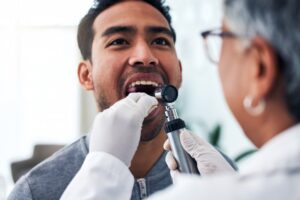
While it may not receive as much attention as other types of cancer, oral cancer is more common than many people realize. It is a serious and potentially life-threatening condition that affects the mouth, lips, tongue, throat, and parts of the neck. Knowing your risk factors can be the first step toward prevention and early detection, and in this post, you’ll find discussion of what those determinants are and how you can avoid an illness.
Understanding Oral Cancer
Oral cancer occurs when abnormal cells grow uncontrollably in the oral cavity or oropharynx (the middle part of the throat). Like most cancers, early diagnosis dramatically increases the chances of successful treatment. Unfortunately, many cases are diagnosed late, which is why understanding your personal risk is so important.
Common Risk Factors for Oral Cancer
Several lifestyle choices, medical conditions, and environmental factors can increase your chances of developing oral cancer. Here are some of the most significant:
Tobacco Use
Smoking cigarettes, cigars, or pipes – and especially using smokeless tobacco products like chewing tobacco or snuff – significantly raises the risk of oral cancer. In fact, tobacco use is the single biggest risk factor, responsible for the majority of cases.
Alcohol Consumption
Excessive alcohol use is another leading contributor to oral cancer. People who both smoke and drink heavily face a dramatically increased risk, up to 100 times greater than those who abstain from both.
Human Papillomavirus (HPV)
The sexually transmitted virus HPV, particularly HPV-16, has emerged as a major cause of oropharyngeal cancers. This form of oral cancer often affects younger individuals and may not be associated with smoking or drinking. Fortunately, HPV-related oral cancers tend to have a better prognosis than others.
Sun Exposure
Extended sun exposure without protection can increase the risk of lip cancer. Just like your skin, your lips need sun protection – consider using a lip balm with SPF when outdoors.
Age and Gender
Oral cancer risk increases with age, particularly after age 40. Men are about twice as likely as women to develop oral cancer, likely due to higher rates of tobacco and alcohol use.
Poor Oral Hygiene and Nutrition
Chronic gum disease, poor-fitting dentures, and a diet low in fruits and vegetables can also contribute to oral cancer risk. Good oral hygiene and regular dental checkups play a key role in prevention.
Signs and Symptoms to Watch For
Early signs of oral cancer can be subtle, which is why regular dental exams are essential. Some symptoms include:
- Persistent mouth sores or ulcers.
- Red or white patches in the mouth.
- A lump or thickening in the cheek.
- Difficulty chewing or swallowing.
- Numbness in the tongue or jaw.
- Hoarseness or a sore throat that doesn’t go away.
Protecting Yourself Starts with Awareness
Oral cancer may be serious, but it’s also highly preventable and treatable—especially when caught early. Avoiding tobacco, limiting alcohol, practicing safe sex, eating a healthy diet, and getting regular dental checkups can all reduce your risk.
Knowing your risk factors is the first step in protecting your health. If you notice any unusual symptoms or have concerns, don’t wait – schedule a dental or medical checkup and talk to a professional.
About the Author
Dr. Mihran Asinmaz is a graduate of Nova Southeastern University and completed a General Practice Residency in the prestigious North Shore – Long Island Jewish Health System. He is also a member of the Academy of General Dentistry and the American Dental Association. At Palm Beach Dental Excellence, preventive dentistry is a huge part of our practice so that we can catch problems like oral cancer before they spread. If you’re concerned that you’re at risk, call our office today to schedule your appointment at (561) 640-9200 or visit our website.
